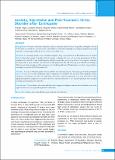Please use this identifier to cite or link to this item:
https://hdl.handle.net/20.500.14356/1598| Title: | Anxiety, Depression and Post-Traumatic Stress Disorder after Earthquake |
| Authors: | Thapa, Prakash Acharya, Lumeshor Bhatta, Bhup Dev Paneru, Suman Bhatta Khattri, Jai Bahadur Chakraborty, Prashant Kumar Sharma, Rajasee |
| Citation: | ThapaP., AcharyaL., BhattaB. D., PaneruS. B., KhattriJ. B., ChakrabortyP. K., & SharmaR. (2018). Anxiety, Depression and Post-Traumatic Stress Disorder after Earthquake. Journal of Nepal Health Research Council, 16(1), 53-57. https://doi.org/10.33314/jnhrc.v16i1.1364 |
| Issue Date: | 2018 |
| Publisher: | Nepal Health Research Council |
| Article Type: | Original Article |
| Keywords: | Anxiety Depression Disaster Post-traumatic stress disorder |
| Series/Report no.: | Jan - Mar 2018;1364 |
| Abstract: | Abstract Background: Prevalence of anxiety, depression and post traumatic stress disorder is high after earthquake. The aim of the study is to study the prevalence and comorbidity of commonly occurring psychological symptoms in people exposed to Nepal mega earthquake in 2015 after a year of the event. Methods: A community based, cross sectional, descriptive study was carried out in Bhumlichaur area of Gorkha district, Nepal after around 14 months of the first major earthquake. We used self-reporting questionnaire 20, Post-traumatic stress disorder 8 and hospital anxiety and depression scale to screen for presence of symptoms of anxiety and depression or post-traumatic stress disorder in this population. The risk of having these disorders according to different socio-demographic variable was assessed by calculating odds ratio. All calculations were done using predictive and analytical software (PASW) version 16.0. Results: A total of 198 participants were included in the final data analysis. The mean age of study participants was 35.13 years (SD=18.04). Borderline anxiety symptoms were found in 104 (52.5%) while significant anxiety symptoms were found in 40 (20%) of respondents. Borderline depressive symptoms were seen in 40 (20%) while significant depressive symptoms were seen in 16 (8%) of subjects. Around 27% (n= 53) of respondents were classified as having post-traumatic stress disorder. Conclusions: The prevalence of anxiety and depressive symptoms and post-traumatic stress disorder seems to be high even after one year in people exposed to earthquake. |
| Description: | Original Article |
| URI: | http://103.69.126.140:8080/handle/20.500.14356/1598 |
| ISSN: | Print ISSN: 1727-5482; Online ISSN: 1999-6217 |
| Appears in Collections: | Vol. 16 No. 1 Issue 38 Jan-Mar 2018 |
Files in This Item:
| File | Description | Size | Format | |
|---|---|---|---|---|
| 1364-Manuscript-3911-2-10-20180314.pdf | Full text Article | 199.88 kB | Adobe PDF |  View/Open |
Items in DSpace are protected by copyright, with all rights reserved, unless otherwise indicated.
